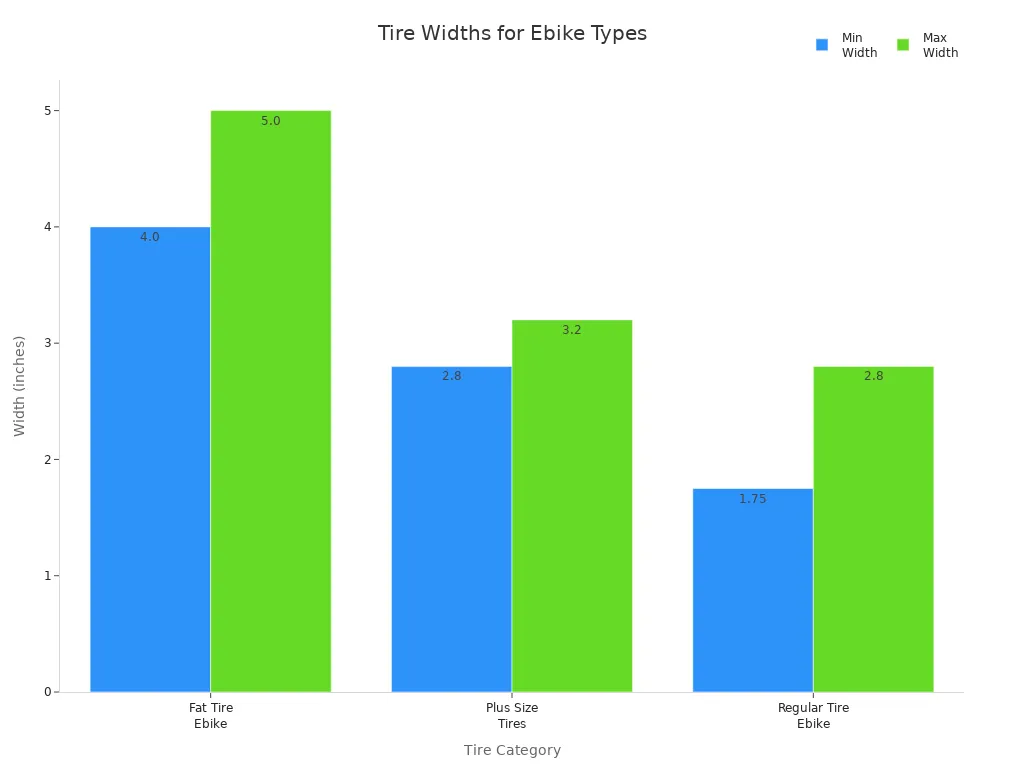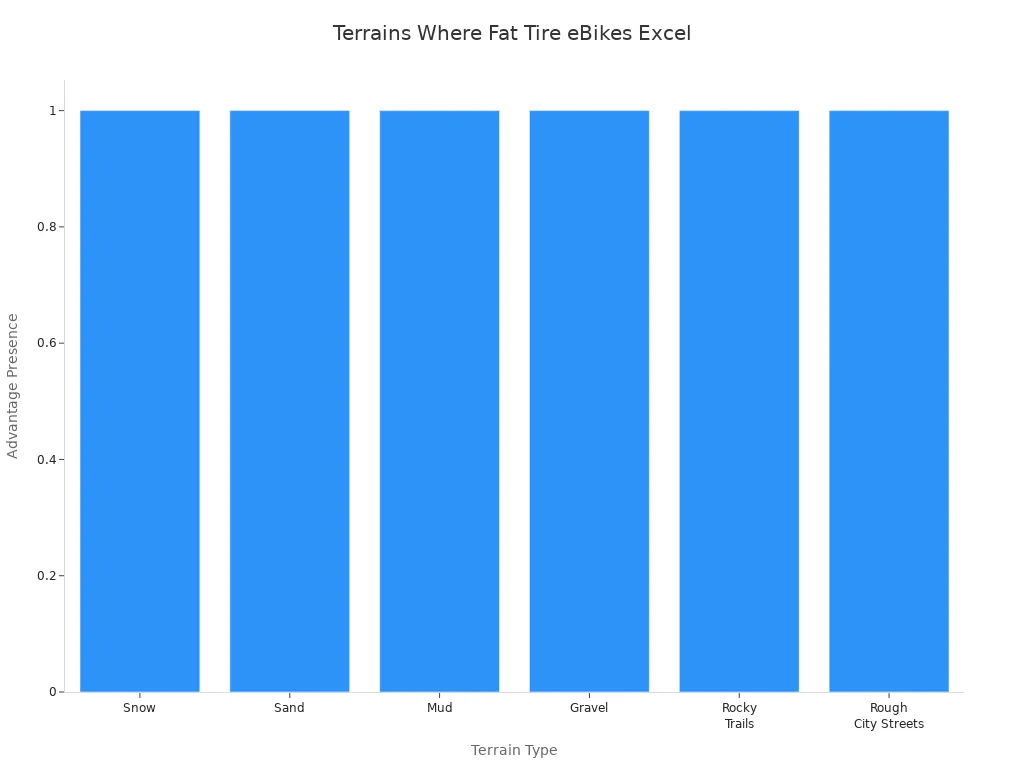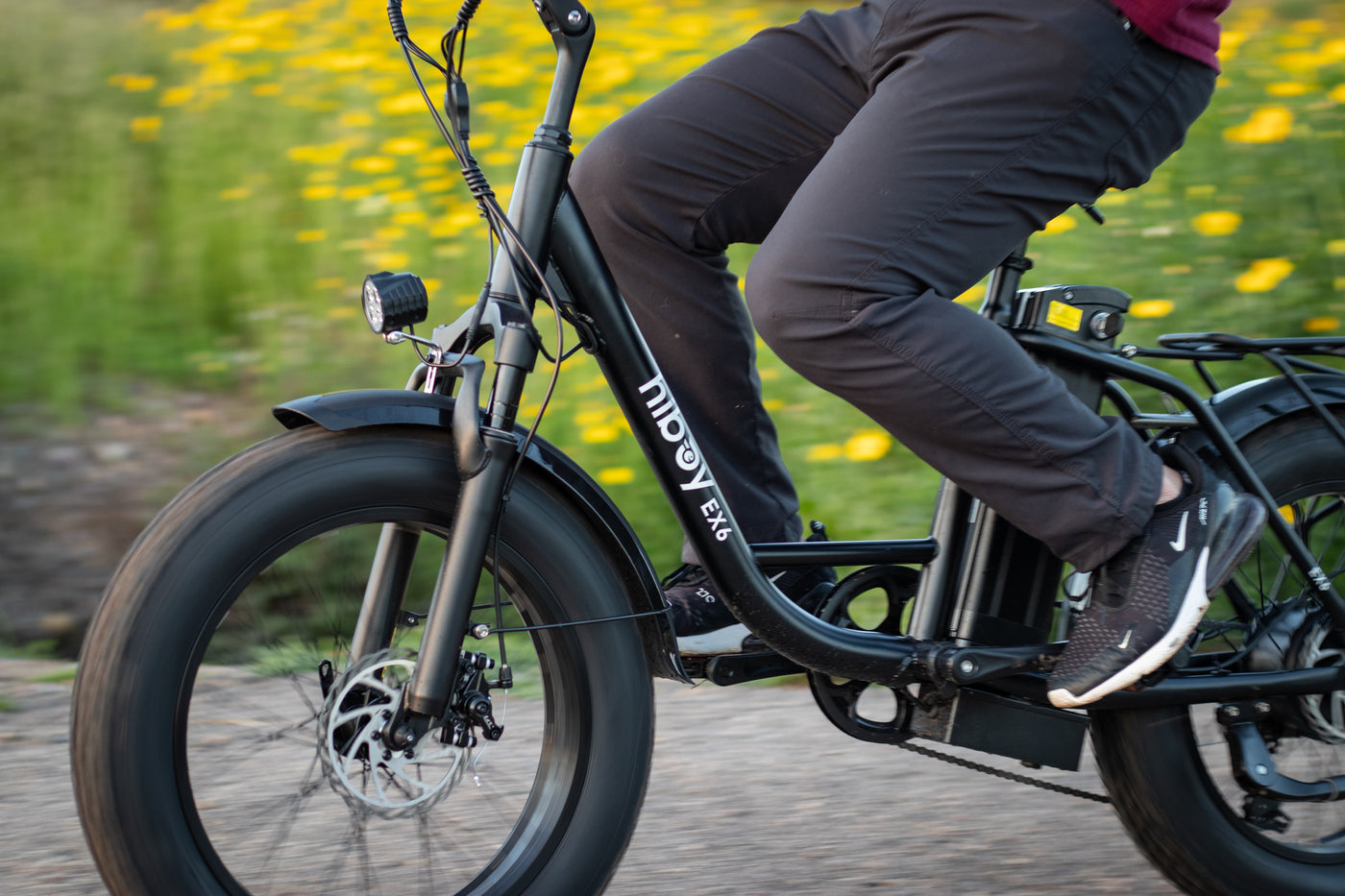Thinking about your next ride? You might find a fat tire ebike fits your lifestyle better than you expect. These bikes stand out for their stability, comfort, and ability to handle rough paths or sand. With a fat tire ebike, you can ride over gravel, snow, or city streets with ease. If you want a smooth trip, a fat tire e-bike gives you that edge over a regular electric bike. Your own riding needs and favorite routes matter most, so picture where you want to go.
Key Takeaways
-
Fat tire ebikes offer superior stability and grip on rough surfaces like sand, snow, and trails, making them ideal for off-road adventures.
-
The wide tires of fat tire ebikes absorb shocks and bumps, providing a more comfortable and smooth ride compared to regular tire ebikes.
-
Regular tire ebikes are lighter, faster, and more efficient on paved roads, perfect for city commuting and daily errands.
-
Fat tire ebikes require more maintenance and use more battery power but allow you to explore diverse terrains with confidence.
-
Choosing between fat tire and regular tire ebikes depends on your riding style, terrain, and comfort needs; test rides help find the best fit.
Fat Tire vs Regular Tire

What Is a Fat Tire Ebike
When you look at a fat tire ebike, you notice the wide bike tire right away. These bikes use tires that are usually 4 inches or wider. The frame is built strong and sturdy to handle the extra weight and power from the motor and battery. You get a longer wheelbase and a relaxed head tube angle, which helps you stay stable on rough ground. Fat tire e-bikes work well on snow, sand, mud, and rocky trails. If you want to ride on the beach or through the woods, a fat tire electric bike gives you the grip and comfort you need. Many electric fat bike models use 20-inch, 24-inch, or 26-inch wheels, so you can pick what fits your style.
What Is a Regular Tire Electric Bike
A regular tire ebike looks more like a classic bicycle. The tires are thinner, usually between 1.75 and 2.8 inches wide. These bikes feel light and quick. You get a frame that focuses on speed and easy handling, perfect for city streets or paved paths. Regular tire electric bikes are great for daily commutes, errands, or even a fun ride in the park. They use less energy, so you can go farther on a single charge. If you mostly ride on smooth roads, a regular tire electric bike keeps things simple and efficient.
Key Differences
You might wonder about the main points in the fat tire vs regular tire debate. Here’s a quick look at how they compare:
|
Tire Category |
Typical Width Range (inches) |
Notes |
|---|---|---|
|
Fat Tire Ebike |
Built with wider frames and rims for stability and all-terrain use |
|
|
Plus Size Tires |
2.8 to 3.2 inches |
Intermediate category offering comfort and traction with better efficiency |
|
Regular Tire Ebike |
1.75 to 2.8 inches |
Includes commuter, hybrid, and mountain ebikes; lighter and more agile on pavement |

-
Fat tire electric bikes use a wide bike tire and a strong frame. You get more stability and comfort on rough or loose ground.
-
Regular tire electric bikes focus on speed and easy handling. You get a lighter ride that works best on pavement.
-
Fat tire e-bikes shine on snow, sand, and trails. Regular tire ebike models are perfect for city streets and smooth paths.
-
Fat tire bicycles are heavier and cost more, but they let you explore more places. Regular tire ebikes are lighter, cheaper, and easier to maintain.
Tip: If you want to ride anywhere, anytime, an electric bike with fat tires gives you the freedom to explore. For daily city rides, a regular tire ebike keeps things fast and simple.
Fat Tire Ebike Benefits

Stability and Traction
You want a bike that keeps you steady, even when the ground gets rough. A fat tire electric bike gives you that confidence. The wide tires spread your weight over a bigger area. This means you get improved traction and stability on gravel, sand, snow, and even muddy trails. You will notice that you can float over obstacles like rocks and tree roots instead of getting stuck or slipping.
-
Fat tires distribute your load across a larger surface, which helps you stay upright on uneven ground.
-
The wide and tough design gives you better traction, so you feel safe on tricky paths.
-
Lower tire pressure lets your electric fat bike glide over bumps and holes, making it easier to control.
-
You get a more comfortable ride because the tires act like cushions, soaking up shocks from rough roads.
When you ride a fat tire electric bike, you will see the advantages of fat tire ebikes every time you hit a loose or slippery surface. Test results show that fat tire electric mountain bikes grip better on wet or loose ground than regular bikes. You will not sink into soft sand or snow. Instead, you stay on top and keep moving forward. This gives you better balance and control, even when the weather turns bad.
Comfort and Shock Absorption
A comfortable ride matters, especially if you spend a lot of time on your bike. Fat tire electric bikes shine here. The benefits of fat tires include extra width—usually 4 to 5 inches—which means more rubber between you and the ground. This extra surface absorbs bumps and shakes from rough trails or city potholes.
-
The wide tires let you ride with lower air pressure, sometimes as low as 5 psi. This makes your ride feel soft and smooth.
-
You will feel less vibration in your hands and arms, even on long rides.
-
Many riders say they feel more confident and relaxed, thanks to the stable and comfortable ride.
Here’s a quick look at how fat tire electric bikes compare to regular tire bikes for comfort and shock absorption:
|
Feature |
Fat Tire Electric Bike |
Regular Tire Electric Bike |
|---|---|---|
|
Tire Width |
3.7 to 5 inches, oversized for better grip |
Narrower tires |
|
Shock Absorption |
Natural shock absorbers, smooth ride on rough surfaces |
Less cushioning, struggles on rough terrain |
|
Stability |
Enhanced stability due to wider contact area |
Less stable on slippery or uneven surfaces |
|
Terrain Capability |
Excels on snow, sand, mud, gravel |
Better on smooth paved roads |
|
Comfort |
Improved comfort by reducing bumps and rough terrain |
Less comfortable on rough roads |
|
Weight Distribution |
Spreads load over larger area |
Concentrated weight, less traction |
You will notice the difference right away. Fat tire electric bikes make rough roads feel smoother. You can ride longer without feeling tired or sore. Many people say their fat tire e-bike gives them a comfortable ride, even on bumpy trails or city streets with lots of potholes.
Terrain Versatility
One of the biggest reasons people choose a fat tire ebike is its versatility for various terrains. You do not have to worry about changing tires or setups when you switch from city streets to off-road trails. Fat tire electric bikes handle snow, sand, mud, gravel, rocky paths, and even rough city roads with ease.

-
Fat tire electric bikes keep their grip on snow and ice, so you can ride all winter.
-
You can lower the tire pressure for soft ground or raise it for pavement, making your bike ready for any surface.
-
The wide tires and strong frame let you carry a heavier load, which is great for camping trips or hauling gear.
-
You get all-season performance, so rain, snow, or mud will not stop your adventure.
Fat tire electric bikes also come with powerful motors and weather-resistant parts. This means you can trust your bike to work well in any season. The off-road biking capabilities of a fat tire e-bike let you explore places that regular bikes cannot reach. You get better traction, more control, and a comfortable ride wherever you go. If you want a bike that does it all, an electric bike with fat tires is the way to go.
Efficiency and Battery Life
Fat Tire Electric Bike Performance
When you ride a fat tire electric bike, you notice the difference in how it handles power and energy. Fat tires give you more grip and comfort, but they also create more rolling resistance. This means your bike uses more energy to move, especially on soft ground like sand or snow. The motor in a fat tire e-bike works harder, but most models come with bigger batteries to help you go farther. You can expect steady performance on rough trails, even if the ride feels a bit slower than a regular e-bike.
Here’s a quick look at how fat tire and regular tire e-bikes compare:
|
Aspect |
Fat Tire E-Bikes |
Regular Tire E-Bikes |
|---|---|---|
|
Tire Width |
Wide (3.5 to 5 inches) |
Narrow (23mm to 28mm) |
|
Tire Pressure |
Low (8-20 PSI) |
High (60-100 PSI) |
|
Rolling Resistance |
High, due to larger contact area |
Low, due to narrow profile and high pressure |
|
Energy Consumption |
Higher energy use, reduced speed and battery life |
Lower energy use, faster speeds, longer range |
|
Comfort & Stability |
Superior shock absorption and stability |
Less shock absorption, more nimble and agile |
Note: Fat tire e-bikes use more energy, but they give you better control and comfort on tough terrain.
Speed and Range
You might wonder how fast you can go and how far you can ride. Regular tire e-bikes usually win when it comes to efficiency and speed. Their lighter, thinner tires roll easily on pavement, so you can ride faster and use less battery. Fat tire e-bikes move slower on smooth roads because the wide tires create more drag. The motor helps, but it cannot fully match the speed of a regular tire bike.
-
Regular tire e-bikes are generally faster and more efficient because of their lighter and narrower tires.
-
Fat tire e-bikes have heavier, wider tires that slow you down on smooth surfaces.
-
Both types can reach speeds up to 28 mph, but regular tire models get there with less effort.
When you look at battery range, fat tire e-bikes often have bigger batteries to make up for their extra weight. Here’s a table to show the average range per charge:
|
Ebike Type |
Battery Voltage |
Average Range per Charge (miles) |
Notes on Performance and Conditions |
|---|---|---|---|
|
Fat Tire Ebike |
48V or 60V |
Larger battery helps with heavy tires and rough ground |
|
|
Regular Ebike |
Typically lower |
30 - 60 |
Lighter build, less rolling resistance |
Keep in mind, riding on sand, snow, or mud will drain your battery faster. Proper tire pressure helps you get the most out of each charge.
Maintenance Needs
You want your bike to last and work well. Fat tire e-bikes need a bit more care because the wide tires and heavy frame put extra stress on parts. You should check tire pressure often, since low pressure can make the bike harder to pedal and drain the battery. Cleaning the tires and drivetrain after muddy or sandy rides keeps everything running smoothly.
-
Fat tire e-bikes need regular checks for tire wear and pressure.
-
You may need to replace tires more often if you ride on rough terrain.
-
Regular tire e-bikes are easier to maintain and cost less to repair.
One of the disadvantages of fat tires is the extra time and money you might spend on upkeep. Still, if you love exploring off-road or want a comfortable ride, the trade-off can be worth it. Every electric bike needs some care, but your choice depends on where you ride and what matters most to you.
Choosing the Right E-Bike
Fat Tire E-Bike Use Cases
You might wonder when to choose a fat tire ebike. These bikes shine when you want to ride on rough or changing surfaces. If you love exploring trails, sandy beaches, snowy paths, or muddy roads, a fat tire e-bike gives you the grip and comfort you need. The wide tires help you stay stable and absorb bumps, so you feel less tired after long rides. You can also carry more gear, which is great for camping or hauling groceries. Fat tire e-bikes work well in all seasons, even when the weather gets wet or icy.
Here are some common reasons riders pick fat tire e-bikes:
-
You ride on gravel, sand, snow, or trails.
-
You want extra comfort and less vibration.
-
You carry heavy loads or need a sturdy bike.
-
You need a bike that handles all types of weather.
Tip: Fat tire e-bikes are heavier and use more battery, but they keep you moving when the path gets tough.
Regular Tire E-Bike Use Cases
A regular tire ebike fits best if you stick to city streets or paved bike paths. These bikes feel light and quick, making them perfect for daily commutes or running errands. You get better speed and battery range because the tires roll easily on smooth ground. Regular tire e-bikes are easier to carry up stairs or onto public transit. They also cost less to maintain.
You might choose a regular tire ebike if:
-
You ride mostly on paved roads or bike lanes.
-
You want a fast, efficient ride for longer commutes.
-
You prefer a lighter bike that is easy to handle.
-
You want simple, low-cost maintenance.
|
Factor |
Fat Tire eBike |
Regular (Thin) Tire eBike |
|---|---|---|
|
Terrain Capability |
Excellent for off-road, trails, sand, snow |
Best for paved roads and city paths |
|
Stability |
High stability and traction on uneven surfaces |
Moderate stability, less suited for rough terrain |
|
Comfort |
Cushioned ride with shock absorption |
Less shock absorption, relies on frame and saddle |
|
Speed & Efficiency |
Slower due to higher rolling resistance |
Faster and more efficient on smooth surfaces |
|
Battery Range |
Typically 20–50 miles per charge |
Typically 40–70 miles or more per charge |
|
Weight |
Heavier (often over 65 lbs) |
Lighter (30–45 lbs), easier to carry |
|
Maintenance |
More demanding due to size and parts |
Easier and cheaper to maintain and replace |
|
Use Case Recommendation |
Best for trail explorers and mixed terrain riders |
Ideal for daily urban commuters and longer rides |
Personal Preferences
Your comfort and riding style matter most. Some riders want a smooth, stable ride and do not mind a heavier bike. Others want speed and easy handling. Fat tires act like shock absorbers, so you feel fewer bumps. This helps if you ride on rough ground or want a relaxed ride. Thin tires make your bike lighter and faster, which is great for city rides or longer trips.
Think about these factors to consider when buying a fat tire ebike or a regular one:
-
Where do you ride most often?
-
Do you want comfort or speed?
-
How much weight do you carry?
-
What feels best when you test ride?
Try both types if you can. A short ride on your usual route will help you decide which bike matches your needs and comfort.
You have a lot to think about when picking your next e-bike.
-
Fat tire e-bikes give you stability, comfort, and grip on tough terrain, but they weigh more and need extra care.
-
Regular tire e-bikes feel lighter and faster on city streets, with less upkeep.
Try both types if you can. A test ride helps you feel the difference in comfort and control. Choose the bike that fits your favorite routes and riding style for the best experience.
FAQ
Are fat tire ebikes harder to pedal without the motor?
You will feel more resistance when you pedal a fat tire ebike with the motor off. The wide tires create more drag. If you want an easier ride without power, a regular tire ebike feels lighter and smoother.
Can I use a fat tire ebike for city commuting?
Yes, you can ride a fat tire ebike in the city. The wide tires handle potholes and curbs well. You might notice the bike feels heavier and slower on smooth roads, but you get extra comfort and stability.
Do fat tire ebikes need special maintenance?
Fat tire ebikes need a bit more care. You should check tire pressure often and clean the tires after muddy rides. The bigger tires may wear out faster if you ride on rough ground. Regular cleaning keeps your bike running well.
How do fat tire ebikes perform in winter?
Fat tire ebikes work great in winter. The wide tires grip snow and ice better than thin tires. You can lower the tire pressure for even more traction. Just remember to dress warmly and watch for icy patches.
Are fat tire ebikes good for beginners?
Absolutely! Fat tire ebikes give you more balance and control. The wide tires help you stay upright, even on tricky ground. If you want a stable and forgiving ride, a fat tire ebike is a smart choice. 🚲











Share:
How to Bring an eBike on Public Transportation (2025)
How Fast Can an Electric Bike Go In Canada? Speed Limits Explained